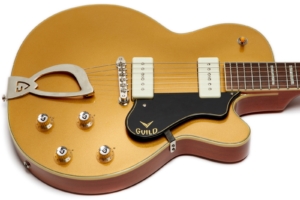
Read on while I go through the process of reviewing this guitar in all it’s goldtop glory.
Introduction
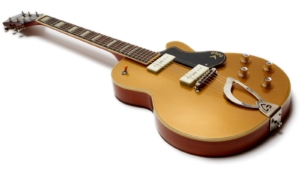
The Newark St. M75 Aristocrat first appears in the 2014 Guild catalog and is described as a Semi-Hollow body guitar with laminated spruce top, solid mahogany back and laminated mahogany sides. There is no mention of color options and sunburst is the only model shown. Note that the M75 Aristocrat in my possession is not semi-hollow like a Starfire IV, but is rather fully hollow like a Starfire III, albeit without the f-holes. Not having access to a 2013 M75, I cannot say for certain that the early models had the same structure, but it would seem likely that the reference to the guitar being semi-hollow is a marketing mistake more than a design change. If you’ve got an early Newark St. M75 that’s obviously semi-hollow leave a comment and I’ll add an update here.
The gold-top version appears in the 2015 catalog along side what appears to be the same image of the sunburst M75 from the previous year’s catalog along with a black model. In this catalog the M75 Aristocrat is described as having a spruce top with mahogany back and sides. There is no mention of laminates, though I seriously doubt that changed. The pickups in the 2015 catalog are listed as SB1s. By 2016 the gold top was gone.
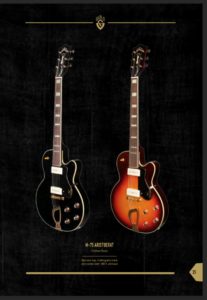
This guitar was made in 2014, and since the goldtops seem to be slightly more desirable on the used market, cost a bit more than other Newark St. M75 Aristocrats that I found. I must say, though, that of the three (Black, Antique Burst, and Gold), I like the goldtop the best by far, at least cosmetically.
Many Newark St. guitars come in gig bags which aren’t great (but then most aren’t unless you pay a premium). This guitar came in a hardshell case which is pretty nice.
Finish
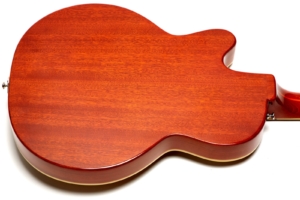
The gold top is really quite beautiful, and while I’m not sure it’s fair to compare it to my 2003 Historic Les Paul R7 that cost almost 10 times what I paid for this guitar, I think I’m going to do exactly that. Hell, let’s thrown in a 2002 Guild Bluesbird for good measure.
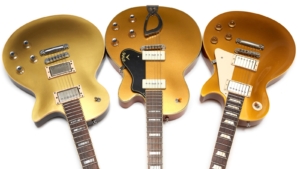
Fretboard and Neck
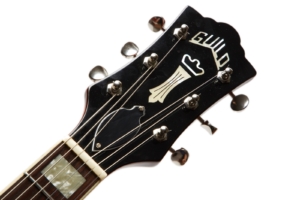
One of the things that I like about the Newark St. guitars I’ve reviewed is the fact that they chose to put taller frets on them when compared with the low wide frets used on many vintage Guilds. The frets on this guitar measured .06″ high and .09″ wide making them in the Extra High for Rock and Roll category on the Dunlop Fret Chart. If you’re used to those old low frets, sliding a barre chord up the neck on this guitar can feel a bit strange, but I love the playability of tall frets. Playing jumbo frets on my Jackson guitars cured me of the monkey grip that I had previously used after years playing a vintage Guild. Speaking of monkeys and grips, if you grip the guitar like a monkey, you’re gonna pull this one out of tune unless you string it up with bridge cables. On my 10-46 strings I can squeeze the plain strings 20-30 cents sharp, and I’m far from super-human.
The fretboard is bound rosewood and the inlays are quite nice pearloid blocks. I’ve seen import guitars with terrible looking plastic inlays but these look great. They don’t quite have the depth of real mother of pearl, but unless you put them side by side with a vintage guitar you’d probably not look twice.
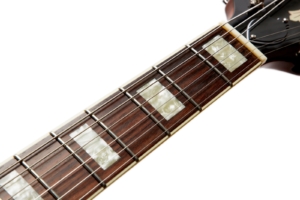
after a couple of cocktails early in the morning.
All in all the neck and frets on this guitar feel great and the fretwork is outstanding.
Build Quality
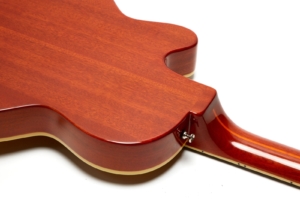
It’s tempting to think that the guitar feels cheap, but that’s not because it’s poorly made — it’s because the guitar is hollow. This guitar is ridiculously light and when compared to one of my Les Pauls that weighs almost twice as much, the Aristocrat is a featherweight. Can it compete with the Les Paul? Well, it’s not really the same kind of guitar.
While my heavyweight Les Paul has P90s (a Historic R4 in this case), the Les Paul is solid mahogany with a solid maple top and this Aristocrat is a very hollow mahogany with a spruce top. That design gives the M75 a very airy quality to its tone that is just not a thing that a solid Les Paul is capable of.
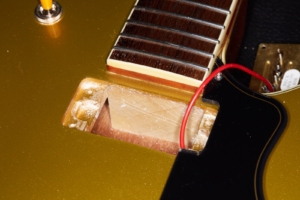
Looking at the ends of the pickup route, you can see additional wood that’s been routed to take the pickup installation screws. These are braces that run under the top along the length of the body much like the braces you would find in a Starfire II or III.
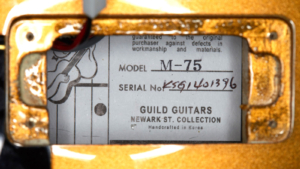
Pickups
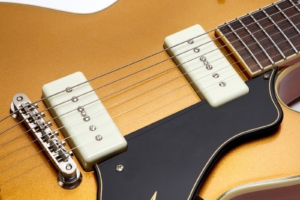
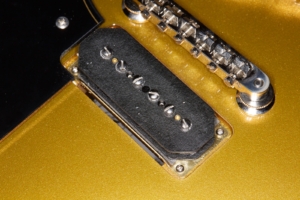
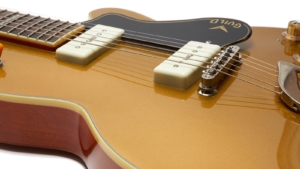
Electronics
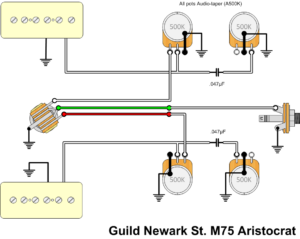
Hardware
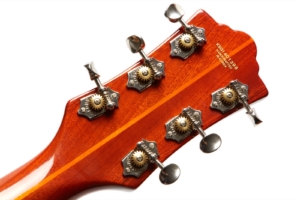
The tuners are Grover Sta-Tites which function fine. I’m just not a fan of the look of them or the tiny peg heads, but that’s clearly a personal gripe since many people are fine with them and they look more or less accurate when compared with the vintage guitars these models are based upon.
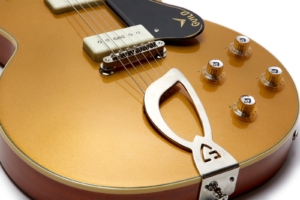
I’m not a big fan of the pick guards on these guitars, again, from a cosmetic standpoint, but they don’t get in my way and function as they should, so once again I’m whining about the looks of the thing which is dumb because it looks very similar to the vintage guitar that inspired it. Sometimes it’s hard to get my head out of the ’80s which is where most of the guitars I review seem to have come from.
Sound
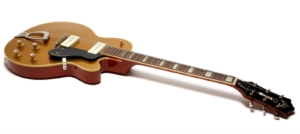
ODS100 Clean
Open Chords #1
Open Chords #2
7th Chords
D-Shape
JCM-800
A Barre Chords
D-Shape
Recto Red
Misc Nonsense
For each recording I cycle through the neck pickup, both pickups, and finally the bridge pickup. All knobs on the guitar are on 10 at all times. The only deviation from this rule in the recordings is the final RV50 sample which was recorded with the bridge pickup because I just couldn’t get enough of that high gain tone.
I was floored by the capabilities of the guitar through a rectifier-type amp, but it really screams through any high-gain rig. While the but it’s a hollow-body purists might rebel against me using such a pretty guitar resplendent with its jazz-like harp tailpiece through a high gain amp, that doesn’t bother me much because they probably wouldn’t come to a high-gain show anyway.
Still, what kind of impressed me about the guitar was its versatility. The fact that it can produce a nice mellow clean sound while also just screaming with that P90 bite and snarl all with that extra something that the hollow body and spruce top provide was just inspiring, and I enjoyed the guitar immensely while searching through my virtual amp collection.
Playability
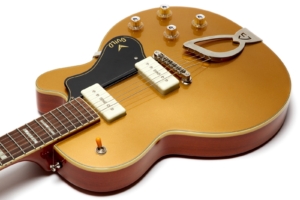
First, this guitar has some pretty great sustain. That surprised me a little bit because I tend to equate sustain with solid blocks of heavy wood, but that’s another “get your head out of the ’80s” problem for me.
Since this guitar is so darn light, it’s a joy to play for extended periods of time both seated and standing, and I have to mention that it’s also a joy to play in any position while unplugged! The hollow nature of the guitar gives it a natural acoustic projection that’s really a lot of fun.
The guitar does like to amplify hum and does not appear to be quieting in the middle position. The guitar also seemed to be a bit of a feedback demon at volume, though it was hardly as tough to wrangle as my Starfire IIIs. Of course if you’re doing more jazz than you are drop-C Djent thumping, this may not be a concern for you.
Conclusion
This guitar surprised me. My experiences with Newark St. Guilds has been sort of hit and miss, but this one is a clear winner with nothing for me to really complain about. In fact, I’d go so far as to recommend it, especially if you can find one for a good price used.
These Newark St. guitars are really only a fair value new, but they’re a fabulous value used. That’s sort of a double-edged sword because it means that they don’t keep their value well, but for a value-hunting musician who wants a great guitar for not a lot of money (and who doesn’t want that?), the M75 Aristocrat Newark St. Guild is a great choice. Just remember that the goldtop will set you back more than the others — if you can find one.
When I was a kid, the vast majority of import guitars were crap. That has changed in a big way and I would have killed for a guitar like this when I was learning how to play. Is this guitar as good as a 1958 vintage Guild M75 Aristocrat? No, but I paid about 1/7th what one of those would have cost me.
All in all I liked this guitar a lot more than I thought I would.
Donate: PayPal Crypto:
ETH: 0x0AC57f8e0A49dc06Ed4f7926d169342ec4FCd461
Doge: DFWpLqMr6QF67t4wRzvTtNd8UDwjGTQBGs

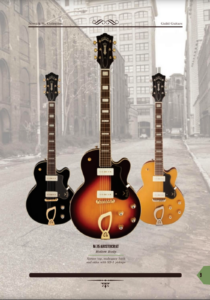

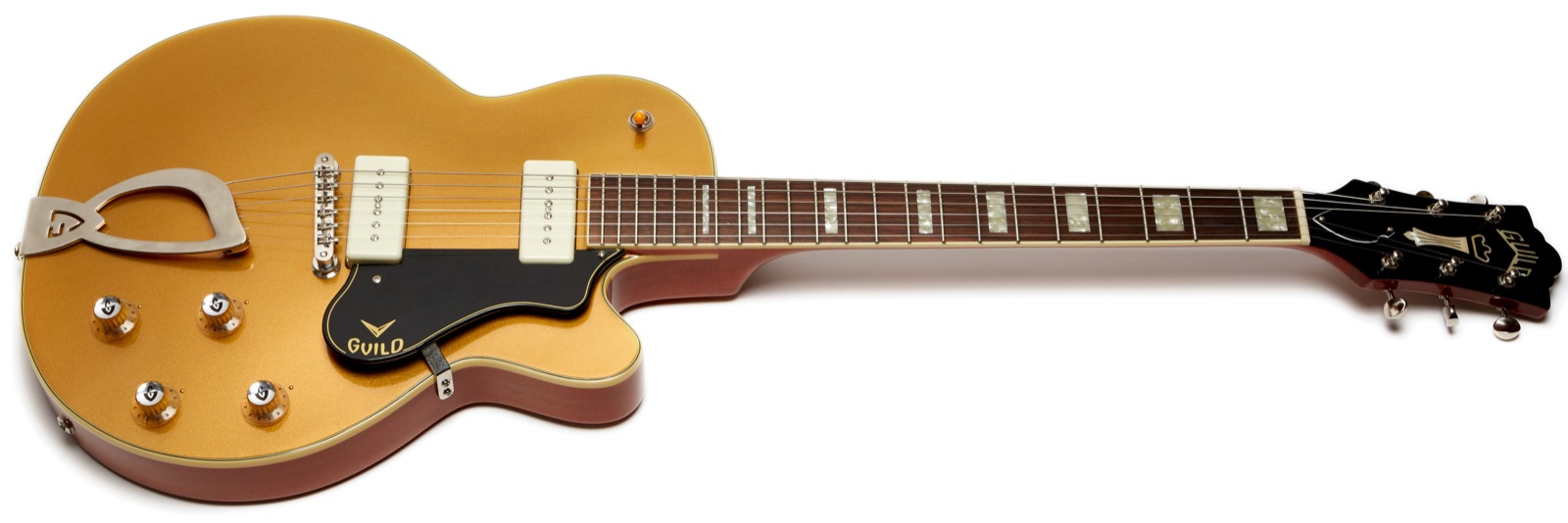

Gary,
Wonderful review, I love this guitar. I especially agree with your assessment of contemporary import guitars. Technology has advanced so much in recent years that Guild, and others, can offer professional, road worthy instruments at this price point. The Newark Street line is light years ahead of the brand new late 1990s Epiphone Emperor Regent I started my giggling career with.
That guitar was boomy and unbalanced at even a moderate volume. The fretwork was rough and inconsistent and the stock pickup was an embarrassment. If I had access to the Newark Street guitars at that time I would have saved trading up three guitars in the years leading up to my acquisition of the M75.
I play a 2014 sunburst Aristocrat. Here is an example of her in action, leading a full band with organ and three horns. It’s Rock Me, Baby from my BB King tribute CD from a couple of years ago:
https://m.soundcloud.com/apicella/rock-me-baby-alt-tk-1-guild-aristocrat-guitar
Gary,
I forgot to mention the most important detail in the tone and playability of my Aristocrat.
When I ordered it from Guild in 2015 I had them scrap the stock tuneomatic style bridge in favor of the rosewood jazz bridge which comes standard on the Newark Street Manhattan and Savoy guitars.
This is possible because the Aristocrat is set up with a floating bridge assembly of two floating feet (which Guild calls “cups”) and a bridge which sits on the guitar’s top and are held in place by the string tension, in the same way any hollow body guitar’s bridge is.
This was my special request, it is not an option they offer but for me it transforms the guitar from unplayable to an awesome jazz machine.
The string radius of the wood bridge is more rounded, which is better for chords, the strings are spaced farther apart, and the action and resonance of the guitars is tighter and more focused. I don’t play metal adjustable bridges because they produce a squishy, wobbly, loose feel. This spongy feel doesn’t work for me, I need the strings to put up a bit of a fight since I play on very low action and I pick hard.
I play .13 Tomastic Infeld flatwound jazz strings. And in taking a cue from BB King’s guitar Lucille, my guitar is named Delia.
So far, the example in my previous reply post is the only record I used her on, but there may be another in the future.
I have had my gold top for 4-5 years now, it’s my main guitar. I did have to replace a V pot but other than that it’s been a great guitar. I had a couple of reverb deluxes when I bought this guitar and loved the sounds, 0 complaints. I now play this through a Vox ac30 and a ac15 head on top of a 2×12 cab loaded with a v30 and a gm12 75w and the sound is amazing. Yeah it has that p90 nasel sound and the Vox does express that more than my fenders but man, it’s a wonderful sound. I use wampler pedals for over drive and yes at time it will howl but once you move around a bit you can manage it and what I keen manage you can grab a note and hold on, it will sing for days . I love my Guild
Hi Gary:
Thanks for the informative review of the M75. I play jazz chord melody and have some concern about the tall frets. Also, not sure how low the action can go. I’m not a tech person- here’s my dumb question: would the height of the bridge PU affect the ability to have very low action? I play with extremely low action due to hand injury.
Again – great review, love the site – including the dogs! Best, Deb
The pickup height should have no bearing on the action since with adjustable pickups you could lower the pickup to whatever you want based on the string position.
High frets are fine with a low action. The issue many people have is that they play with a death grip and that causes the strings to pull sharp. If you play with a light touch on your fretting hand then the fret height is not a problem.
Thanks for the kind words!
Thanks for your reply – very helpful. I do have a very light touch. Will consider getting an M75 as they are reasonably priced used. Can’t find a gold one, though!
Best, Deb
Hi Gary,
thanks for that superb review.
I‘ve owned an X-175B Manhattan that I stupidly sold (very great guitar) and always wanted a goldtop M75. Tada, finally I‘ve found one and it should arrive (hopefully save and sound) in ten days from now…fingers crossed.
But please tell me- the harness looks more or less cheap. Are those Alpha pots? I guess it‘s a pita to get the harness swapped. Ground wire sits on the screw of the Guild harp?
Thanks, stay safe and healthy
Stefan (from germany)
I no longer have the guitar, but this is what the harness looks like: https://shop.guildguitars.com/product/newark-st-collection-wiring-harness-for-x-175m-75/?v=7516fd43adaa
Great info/review!! Thanks!
I was immensely surprised by the ultra rolled edges on the fretboard, and the very high quality of the over-all fit and finish. I had previously bought a Starfire I before my Aristocrat, and while the Indonesian Starfire I was a very high quality for a $700 instrument, the Korean Aristocrat blows it out of the water. My only gripe is the pots. I know, and easy fix, but a simple upgrade (a la Epiphone switch to all CTS) would help immensely. I never expected to fall for Guild, but a nearly accidental purchase of the Starfire I while waiting for an Olive Drab Casino that was hopelessly backordered has led to a new love affair. My Aristocrat has kept been my go-to since I received it in December. Amazing guitar. How do they not sell more of these?
Hi Gary, thank you for review, it is very informative. I recently bought a gold top M-75 for $680 Canadian (~500 US). It has an issue with the toggle switch that does not play both pickups in the middle position. I may need to replace the toggle switch but wonder if you may know if this switch is custom made for the M-75 or if any other similar switch would work.
Thanks,
Paco
There is nothing custom about the switch, but it is probably metric so obtain measurements before ordering a replacement.
You may also be able to just clean (use contact cleaner) or *very* lightly sand the contacts on the switch to make it work again. Sometimes switch contacts can get corrosion on them that prevents them from working properly.
Great, thanks for the response.
Cheers!
Paco